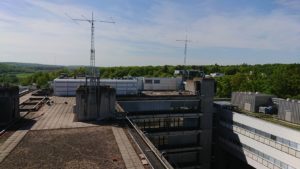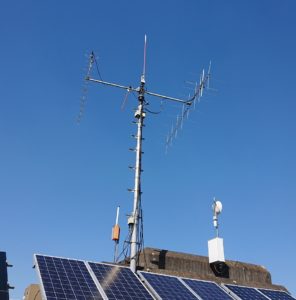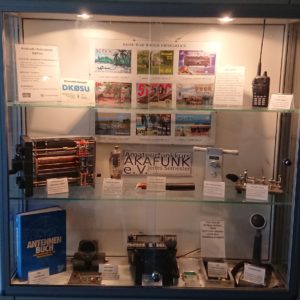In the end of March, ARK-member Frode (LB1HH) went with his student orchestra “Dei Taktlause” for a trip to Stuttgart. The orchestra had been invited down by the local “ACO” student orchestra, as one of their members had been in Trondheim and played with Dei Taktlause as an exchange student the year before. As a part of the trip, the two orchestras would host a concert on the Stuttgart university campus, and it was during this concert LB1HH spotted some familiar-looking antennas on the roof of one of the university buildings. After a bit of research, an email was sent to the local student amateur radio club: Akademische Funkgruppe der Universität Stuttgart, or AkaFunk for short. Eager to meet up with other amateur radio enthusiasts, LB1HH had used the opportunity to ask for a tour at the AkaFunk club. This is what LB1HH has to say:
I did not expect there to be many other student amateur radio clubs around, so when I saw the antennas I was really curious how they would compare to ARK here in Trondheim, and I would love to have a chat with them. It was a no-brainer to ask for a tour once I knew about them!
The concert was being held on a Thursday, and we had plans scheduled for both the Friday and Saturday. The only day that really would work for a visit was the Sunday, which was put up as a break day in the schedule. This was convenient, as it gave AkaFunk some time to reply to my short notice email. During the Saturday, I got a response from Benedict (DL8BJS) at AkaFunk and we were able to agree on a time at 14:00 the following day. For the occasion I also arranged someone at ARK, Julian (LB5QG), who would be available at the time to attempt a sked on 20 m between Trondheim and Stuttgart.
AkaFunk uses the callsign DK0SU, and has been active since 1974. Unlike ARK, AkaFunk has a shack at the roof of the university premises. Also unlike ARK, some professors and employees at the university are active members of the club. They have their antenna park spread around on the roof of the university, and it includes a 2 m/70 cm/23 cm beam, a 10 GHz beacon and pair of HF Yagis to name a few.

HF Yagi antennas at AkaFunk. Left one is for 20 m, right one is for 10 m-17 m. There are also wire-dipoles hanging over the university backyard.
As DL8BJS was quite fresh in the club, having joined only a few months prior, we had some problems getting into the university building. After a while of looking for a door that would be open for students on a Sunday, we managed to catch a university employee who was kind enough to let us in. One of the first things meeting us as we got closer was a small exhibit of amateur radio equipment. This was a nice nod to the clubs history, and serves a nice presentation of the amateur radio hobby to anyone who might pass by.
When reaching the shack, we had a short break, before heading back out to look at the antennas. We had been very lucky with the weather, and it was clear sky with almost no clouds. AkaFunk was well equipped for the typical bands, and the roof had plenty of space to host the antenna-park. After having the round, we went back to the shack for the sked with LA1K.
The shack of AkaFunk is very neat and tidy. The stations for the different bands were nicely organized, and everything you would need for operating a station would be within an arms-reach distance. Sufficient space behind the shack made for a very nice overview of the signal routing. When we had the radio up and running, we found an open frequency and I notified LB5QG in Trondheim where to call. Unfortunately the HF amplifier at AkaFunk was in for repair at the time, so we had to make do with 100 W out. As expected, we managed to hear LA1K very clearly, and also as expected we barely made it through the noise back in Trondheim. This is a common and known problem, as Trondheim’s high latitude results in more cosmic noise and a higher noise-floor than further south. At this point in the sunspot cycle, getting through at all from afar on voice can be a real challenge. As Julian at ARK could barely make out what we were saying, the conditions were by far good enough to hold any sort of longer conversation.
After the sked, I had a good conversation with DL8BJS, learning a lot about him and AkaFunk in the process. Turns out that although ARK and AkaFunk have some differences, there is quite a bit of things I found familiar as well. The routines at AkaFunk reminds me quite a bit about both current and old routines at ARK, and in particular when it comes to logging. AkaFunk still uses a paper-log for non-contest operation the exact same way we used to back before going fully digital, but taken into consideration, ARK has only logged fully digital less than a decade.
All in all, the visit was great and very insightful! I got to know another student radio amateur enthusiast, learn about his club, and even run a pair of QSOs with LA1K in Trondheim. Many thanks to him for showing me around, and I will certainly consider dropping by again if I am in the area at a later time.






Leave a Reply